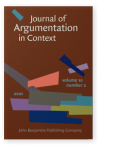Vol. 10:2 (2021) ► pp.171–201
How do scientists criticize the computer metaphor of the brain?
Using an argumentative pattern for reconstructing resistance to metaphor
The central metaphor in cognitive science is the computer metaphor of the brain. In previous work, we reconstructed the metaphor in a novel way, guided by the assumption that it functions as an explanatory hypothesis. We developed an argumentative pattern for justifying scientific explanations in which this metaphor functions as a standpoint supported by argumentation containing abduction and analogy. In this paper, we use the argumentative pattern as a heuristic to reconstruct recent scientific criticisms against the computer metaphor. The pattern generates expectations about the nature of these criticisms, and we show those expectations to be met in most respects. We then discuss the extent to which our findings render the reconstruction offered by the argumentative pattern feasible. A central question emerging from our analysis is whether the computer metaphor can be adequately characterized as an explanatory hypothesis based on abduction. We suggest some possibilities for future lines of inquiry in this respect.
Article outline
- 1.Introduction
- 2.An argumentative pattern as a heuristic
- 2.1Argumentative patterns
- 2.2An argumentative pattern for justifying the computer metaphor of the brain
- 2.3An argumentative pattern as heuristic for analyzing counter-argumentation
- 3.Analyzing criticism of the computer metaphor in Sensorimotor Life: An Enactive Proposal
- 3.1Introduction of the case
- 3.2Matching counter-arguments to the argumentative pattern
- 1.1′Computation best explains how cognition turns perception into behavior
- 1.1′.1aComputation explains how cognition turns perception into behavior
- 1.1′.1a.1Computation explains how computers turn input into output
- 1.1′.1a.1′Turning input into output is comparable to turning perception into behavior
- 1.1′.1bThere are no other equally good explanations
- 1.1′.1b.1Alternative explanations D, E and F suffer from Q, R, and S
- 1.1′.1cA computational explanation is empirically testable
- 1.1′.1dA computational explanation coheres with other established theories
- 1.1′.1eA computational explanation is simple/elegant
- 1.1′.1fA computational explanation has explanatory force
- Argument not matching the argumentative pattern
- 4.Discussion and conclusion
- Notes
-
References
